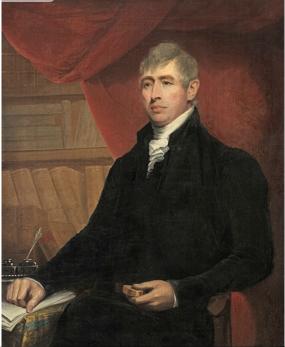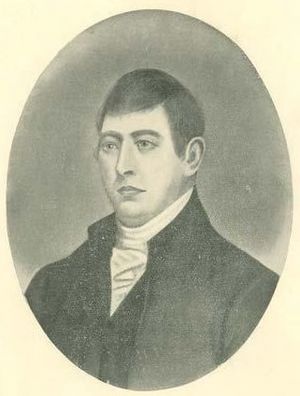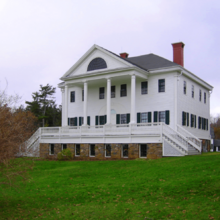Richard John Uniacke facts for kids
Quick facts for kids
Richard John Uniacke
|
|
|---|---|

Richard John Uniacke by Robert Field
|
|
| Born | November 22, 1753 Castletown, Kingdom of Ireland
|
| Died | October 11, 1830 (aged 76) Mount Uniacke, Nova Scotia
|
Richard John Uniacke (born November 22, 1753 – died October 11, 1830) was a very important person in the history of Nova Scotia. He was a lawyer, a politician, and a strong supporter of ending slavery. He also worked to give more rights to Catholics. Historians say he was one of the most influential Nova Scotians of his time. He spent 49 years working for the public in Nova Scotia. His home, the Uniacke Estate Museum Park, is now a museum.
Contents
Early Life in Ireland
Richard John Uniacke was born in Castletown, County Cork, Ireland. His family had a large estate nearby. He went to school in Lismore. When he was sixteen, he became interested in the Catholic faith. This was a problem for his Protestant family. His father sent him to Dublin to study law.
In Dublin, Richard became interested in Irish politics. He joined a group that wanted more freedom for Ireland. This caused problems with his father, who stopped giving him money. Richard left his studies in 1773 and decided to go to North America to find his own way.
Adventures in the West Indies and New England
Uniacke first went to the West Indies in December 1773. He visited St. Kitts, where his older brother was in the army. However, he quickly disliked the harshness of plantation slavery there. He then moved to Philadelphia in 1774.
In Philadelphia, Uniacke met Moses Delesdernier. Delesdernier was a merchant who was helping people settle in the Isthmus of Chignecto area of Nova Scotia. Uniacke decided to join him as a partner.
Life in Nova Scotia
Uniacke arrived in Nova Scotia in 1775. He found the conditions tough but enjoyed exploring the frontier.
American Revolution and Loyalty
In 1776, Uniacke joined the American rebels during the Battle of Fort Cumberland. This was despite his father-in-law, Moses Delesdernier, remaining loyal to the British. The American rebels, led by Jonathan Eddy, tried to take over Fort Cumberland. They also took supplies from people loyal to the British. Uniacke was captured while trying to get supplies for the rebels.
He was sent to Halifax as a prisoner. Being a rebel meant he could be charged with treason, which could lead to being hanged. But because of his family connections and because he helped the British by giving evidence, he was released. After this, Uniacke developed a strong dislike for Americans. He once called them "a race of the most lawless... monsters."
Joining the Government
Seven years after the American Revolution, Uniacke became a member of the Nova Scotia House of Assembly. He served for over twenty years, representing different areas. In 1808, he was appointed to the Nova Scotia Council, which was like an upper house of government.
Fighting for Catholic Rights
Uniacke worked hard to change laws that were unfair to Catholics in Nova Scotia. In 1783, he helped rewrite a law that had restricted Catholics since 1758. This new law allowed Catholics to own land, build churches, and have priests.
In 1786, he helped start the Charitable Irish Society of Halifax. This group helped Irish people, whether they were Protestant or Catholic. Uniacke continued to push for more changes. He helped pass laws that allowed Catholics to open schools and vote. His efforts eventually led to full rights for Catholics with the Roman Catholic Relief Act 1829.
Ending Slavery in Nova Scotia
Many Black people came to Nova Scotia during the American Revolution. Some were free, but others were slaves brought by loyalists. Britain had already started to outlaw the slave trade in 1772.
Uniacke was a leader in the fight against slavery in Nova Scotia. In 1787, 1789, and again in 1808, the Nova Scotian government refused to make slavery legal. Uniacke stopped efforts by others to make slavery a legal practice in the colony. The Slave Trade Act 1807 outlawed the slave trade in the British Empire in 1807. Later, the Slavery Abolition Act 1833 completely ended slavery.
Encouraging Immigration
As Attorney General, Uniacke wanted Nova Scotia to grow. He worked to bring more immigrants to the colony. He pushed for the government to start giving out free land again to settlers. He also took back large areas of land from people who were just holding it to make money, not to settle it. By 1820, he had taken back about 100,000 acres (400 square kilometers) of land. This land was then given to new immigrants. Nova Scotia's population grew from 75,000 people in 1815 to 200,000 in 1838.
Supporting Education
Uniacke also played a key role in starting University of King's College in Windsor in 1789. Even though he was not Anglican, he served on the college's board.
Military Service
During the French Revolutionary Wars and Napoleonic Wars, there was always a fear of invasion in Nova Scotia. To protect the colony, Nova Scotia had a militia. In 1793, Uniacke was second-in-command of a militia battalion. In 1794, he was promoted to Lieutenant-colonel.
Conflicts with Others
Uniacke often spoke for the early settlers of Nova Scotia. This sometimes put him in conflict with powerful new officials, like Sir John Wentworth, 1st Baronet, the Lieutenant Governor, and judge Sampson Salter Blowers. Blowers even challenged Uniacke to duels twice.
One conflict happened when another lawyer accused Uniacke of being unfair to Loyalists in court. This led to a street fight between Uniacke and the lawyer. The lawyer was not well and died shortly after. Blowers blamed Uniacke and challenged him to a duel. The duel was stopped by the local authorities, but Uniacke and Blowers remained enemies.
Idea of Confederation
Uniacke was the first public figure to suggest that the Canadian colonies should unite. This idea, called Confederation, became a reality 51 years later. He believed that uniting the colonies would protect them from the ideas of the United States.
In 1806, he presented his ideas about British North America to the British government. In 1826, he wrote a paper called "Observations on the British colonies in North America with a proposal for the confederation of the whole under one government." Parts of his ideas were very similar to the British North America Act, 1867, which created Canada many years later.
Uniacke's Family
Soon after arriving in Nova Scotia, Uniacke married Martha Maria Delesdernier in 1775. She was 12 years old. They had eleven children together before she passed away in 1803. In 1808, he married Eliza Newton, and they had one son. In total, he had twelve children. Three of his sons became lawyers, and one became a priest.
His son James Boyle Uniacke was also a lawyer and became the first Premier of Nova Scotia. Another son, Richard John Uniacke, Jr., was a lawyer, a judge, and a politician.
His son Norman Fitzgerald Uniacke also studied law. He became the Attorney General of Lower Canada (now Quebec) and later a judge. He was known for being fair to French Canadians.
His youngest son, Andrew Mitchell Uniacke, practiced law in the family firm. Another son, Crofton Uniacke, also practiced law and became a judge before moving to England. Richard's son Robert Fitzgerald Uniacke chose a different path and became a minister at St. George's Church in Halifax.
Uniacke Family at St. Paul's Church
The family of Richard John Uniacke is remembered with many plaques and monuments inside St. Paul's Church (Halifax).
Uniacke's Legacy
Richard John Uniacke's large estate, built around 1813, is now the Uniacke Estate Museum Park in Mount Uniacke, Nova Scotia. It is preserved as a historical site.
See also









